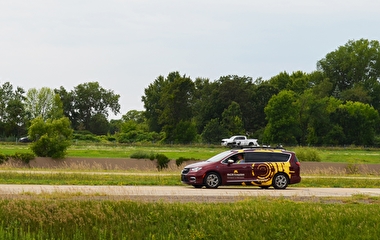such as autonomously detecting and avoiding obstacles.
If connected and automated vehicle (CAV) technology will significantly change how we travel, then it’s also bound to impact the work of those who design our roadways, operate our transportation systems, and enforce traffic laws.
“As more vehicles with these capabilities enter the national fleet, transportation professionals will need to expand the scope of their work to maximize the benefits of this technology and avoid or mitigate its risks,” says U of M researcher Brian Davis. “We’re asking them to take on a new set of responsibilities and to do so competently and extremely quickly.”
To help them prepare, Davis and fellow researcher Reed Johnson, both with the Department of Mechanical Engineering, created several training modules as part of a project sponsored by the Roadway Safety Institute. The training, Davis says, attempts to bridge the gap between the U of M’s CAV research and transportation professionals and practitioners interacting with technology in practice.
A two-day pilot workshop was held on the U of M campus in May for eight transportation professionals representing different public agencies. The workshop included both classroom-based lecture sessions and outdoor demonstrations with a Husky unmanned ground vehicle—an outdoor-ready robotic vehicle made by Clearpath Robotics.
Davis says he chose topics based on interest from project stakeholders and applicability to CAVs operating in northern climates like Minnesota’s.
“Our primary goal was to develop foundational technical literacy when it comes to some of these CAV technologies,” Davis says. “Ideally, this will provide participants with a context when discussing these technologies with researchers, vendors, implementers, and other professionals.”
According to Davis, other related courses for professionals generally focus on system-level overviews or policy considerations of CAV networks. The U of M workshop chose to focus on lower-level enabling technologies for CAVs including GPS/GNSS, LIDAR, computer vision, and navigation algorithms. “We think that focusing on foundational knowledge will help transportation professionals by providing context when dealing with these technologies in the course of their work,” he says.
One participant, Major Sean Meagher with the Minnesota State Patrol, says his agency works closely with MnDOT’s CAV-X Office and monitors current events and industry trends.
“CAV technology will have a tremendous impact on traffic safety in the future,” Meagher says. “In Minnesota, on average 350 to 400 people die each year on our roadways. Almost all, if not all, are due to human contributing factors. CAV technology will certainly have a positive impact on lowering traffic fatalities in the coming decades.”
Workshop participant Rick West, Otter Tail County Public Works director, says that from a practitioner point of view, he appreciated learning how the technologies interrelate. Although he has no first-hand CAV experience yet, he’s been part of research projects dealing with dynamic in-vehicle warning technology for horizontal curves and high-accuracy mapping of local road pavement edges for future vehicle guidance.
“Being responsible for local roads and bridges, I believe that we will be involved at some point in providing quality pavement markings and highly accurate GPS-referenced infrastructure location data to help guide these vehicles,” West says.
Because response to the workshops was overwhelmingly positive, Davis hopes to incorporate participant feedback and offer additional workshops in the future.




